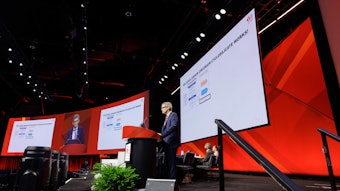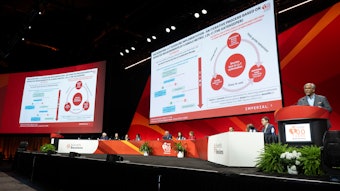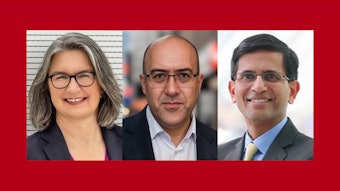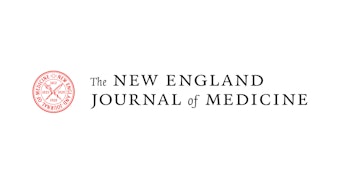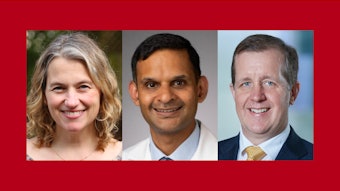Dissecting the complex relationship between atrial cardiomyopathy and stroke
Paul Dudley White Lecture lays groundwork for promising patient outcomes.
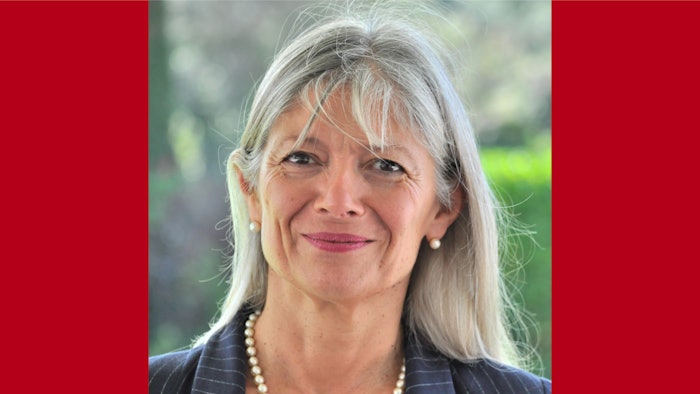
Atrial cardiomyopathy is one of the most diagnosed cardiovascular diseases in the United States, surpassing even coronary artery disease in developed countries.
As a risk factor for ischemic stroke, heart failure and premature death, it is debilitating — particularly for older people — and is a considerable health system burden.
Despite the challenges, Barbara Casadei, MD, DPhil, FRCP, FMedSci, FESC, maintains that much of atrial cardiomyopathy’s role in ischemic stroke is up for debate.
Casadei is a professor of cardiovascular medicine and head of Imperial College’s National Heart and Lung Institute in London. She delivered Sunday’s Paul Dudley White International Lecture and Session, “Atrial Cardiomyopathy and Ischemic Stroke: The Jury Is Out.”
“This is an area of intensive research. Several investigators have reported metabolic changes in atrial tissue. Others have highlighted the importance of interstitial fibrosis. But because the atrial wall is so thin, it is difficult to assess these changes in vivo and in patients reliably,” Casadei said.
“For this reason, the research community has focused on risk factors and on plasma, imaging or EKG-derived biomarkers of atrial cardiomyopathy and cardioembolic stroke risk,” she said. “Much research is ongoing, but to date it remains unclear whether this effort will translate into practical solutions that will improve risk assessment and prevention of cardioembolic stroke.”
Casadei’s work represents advances in the understanding of the relationship between atrial cardiomyopathy, atrial fibrillation and stroke. By expanding the focus from AFib to now include atrial cardiomyopathy, her work may pave the way for improved stroke prevention and care.
“Better understanding of this complex relationship may help us reduce the burden of stroke, identify patients at risk of developing heart failure and enhance the quality of life of millions of patients around the globe,” Casadei said.
Current treatments for AFib, such as pulmonary vein isolation or antiarrhythmic drugs, improve symptoms and quality of life, but AFib recurs and the benefit of these approaches in reducing stroke risk remains uncertain.
“AFib is a combination of a trigger and a substrate that facilitates the initiation and maintenance of the arrhythmia,” Casadei said. “Although it is unlikely that all ectopic beats from the pulmonary veins result in AFib, the combination of a trigger and an atrial cardiomyopathy substrate will provide a ‘fertile terrain’ for AFib to take root. Whether we will be able to prevent or reverse the atrial cardiomyopathy substrate is an ongoing challenge.”
Traditional thinking is insufficient to explain all clinical observation. Casadei’s research has shown that molecular, structural and electrical changes that precede or accompany the onset of AFib may contribute to stroke risk independent of AFib. Her research emphasizes a need for a new model of stroke risk prediction that accounts for both AFib and atrial cardiomyopathy. This model could lead to more personalized and effective AFib and stroke prevention strategies, she said.
But, to date, efforts to test the use of anticoagulation in patients with cryptogenic stroke with or without evidence of atrial cardiomyopathy have not produced positive results.
“Whether this is because the biomarkers that have been used to identify atrial cardiomyopathy lack specificity or direct mechanistic links with atrial thrombogenesis remains to be explored. Investigators that define atrial cardiomyopathy based on local inflammation or left atrial flow characteristics may reach different conclusions,” she said.
Casadei’s research also underscores the importance of imaging methods to identify patients at high risk of stroke. Techniques such as advanced cardiac magnetic resonance imaging and computed tomography aided by artificial intelligence applications will be crucial for identifying and subclassifying atrial cardiomyopathy and the associated stroke risk. New tools and the availability of larger and larger datasets may open the possibility of teasing apart different types of AFib that may require different treatment and carry different risks.
“Our priority now is to find a way to bridge the gap between understanding the mechanisms of atrial cardiomyopathy and applying this knowledge to improve patient outcomes through prevention and treatment,” she said.


